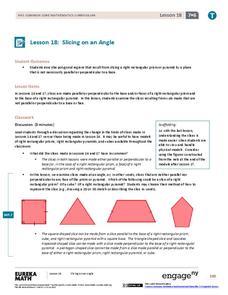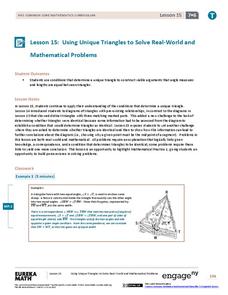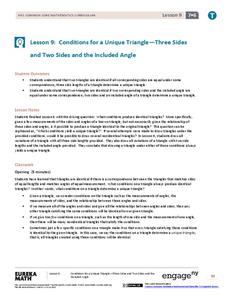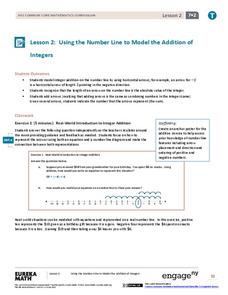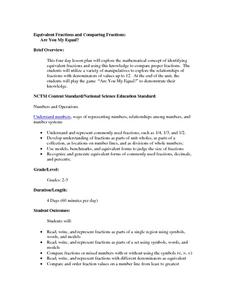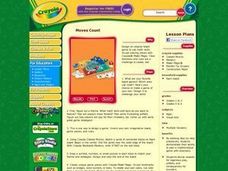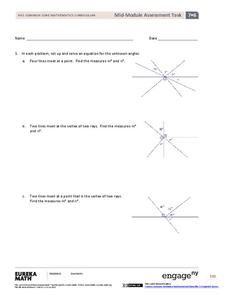EngageNY
Surface Area II
Examine the surface area of composite figures using an exploratory approach. As a continuation of the previous lesson plan of the 29-part series, young scholars develop plans for finding the surface area of composite figures. Examples...
EngageNY
Slicing on an Angle
No matter how you slice it, it's still a polygon! An engaging lesson examines the different ways you can slice a prism. The lesson begins with simple parallel and perpendicular slices. It then challenges scholars to slice the prism to...
EngageNY
Using Unique Triangles to Solve Real-World and Mathematical Problems
How can congruent triangles help mark a soccer field? This is just one question your classes can answer after solving the real-world problems in the activity. Each example posed through a word problem elicits higher-order thinking and...
EngageNY
Conditions for a Unique Triangle—Two Angles and a Given Side
Using patty paper, classes determine that only one triangle is possible when given two specific angle measures and a side length. As the 10th instructional activity in the series of 29, young math scholars add these criteria to those...
EngageNY
Conditions for a Unique Triangle—Three Sides and Two Sides and the Included Angle
Building on the previous lesson in the 29-part series, the ninth lesson asks individuals to construct a triangle given specific criteria. First, they are given three specific side lengths, followed by two sides and the included angle....
EngageNY
Using the Identity and Inverse to Write Equivalent Expressions
The fifth installment in the series of 28 lessons helps math scholars explore the result of adding opposite numbers and multiplying reciprocals. Through this exploration, they develop a working definition of identity and inverse properties.
EngageNY
Applying the Properties of Operations to Multiply and Divide Rational Numbers
Use properties to evaluate several multiplications and divisions. The 16th lesson in a series of 25 demonstrates to scholars how they can utilize properties of operations to evaluate complex numerical expressions involving multiplication...
EngageNY
Solving Equations Using Algebra 2
If you use a fabulous lesson plan, then your pupils can become fabulous at solving equations. The 24th installment of 25 incorporates the use of if-then statements to illustrate the properties of equality used in solving two-step linear...
EngageNY
Efficiently Adding Integers and Other Rational Numbers
Develop the rules for adding rational numbers. Pupils continue to work on adding integers. Young mathematicians use their experiences to develop the rules for adding integers with like and unlike signs. They finish the lesson plan by...
EngageNY
Understanding Addition of Integers
Count up or down to find sums. The third lesson in a 25-part series uses number lines to build an understanding of the sums of integers. Pupils make the connection between the distance and direction of a sum from the first addend, then...
EngageNY
Computing Actual Areas from a Scale Drawing
Square the scale factor when working with scaled drawings and area. The 19th lesson in a series of 22 introduces calculating actual areas from scale drawings. The lesson encourages pupils to use the square of the scale factor to find the...
EngageNY
Unit Rate as the Constant of Proportionality
What do unit rates and constants of proportionality have in common? The lesson plan addresses this question and introduces the concept of constant proportionality to the class. Individuals find that the unit rate and the constant of...
PBS
Using Variables in Simple Equations
A Cyberchase clip shows Hacker creating a game show that uses a variable to find out how much power is produced by a gleamer bug. Follow the video with a lesson about using variables to solve equations. Terrific handouts and...
Project Maths
Inequalities
Which number is bigger? Using a variety of activity sheets, this unit starts with the basics of inequalities and progresses through solving compound linear inequalities. Problems cover the range of inequalities including inequality word...
EngageNY
Comparing Tape Diagram Solutions to Algebraic Solutions
Learners solve vacation equations using tape in a lesson plan that utilizes tape diagrams to aid in understanding the algebraic steps involved in solving two-step linear equations. Groups work together to solve seven scenarios involving...
EngageNY
Using the Number Line to Model the Addition of Integers
The second lesson in a series of 25 shows the class how to use arrows and a number line to add integers. Learners apply their knowledge of the commutative property and absolute value in their explanations. Classmates play the integer...
Curated OER
Equivalent Fractions and Comparing Fractions
How can you tell if fractions have equal value? Use various collaborative activities to demonstrate the ways to determine whether or not fractions are equivalent.
Curated OER
Budget Mania
Students examine several examples of budgets to develop a facility with the components of its formation. Income, expenses, and expenditures are considered and itemized for this lesson plan.
Curated OER
Teddies
Here's a really cute lesson that utilizes all of your children's teddy bears. Each pupil brings their favorite teddy bear to school. The lesson has many wonderful suggestions for learning activities that can be done with the bears once...
Curated OER
Moves Count
After brainstorming all the board games they enjoy playing, learners design an original board game with a theme to utilize their math and art skills. They sculpt playing pieces and write clear directions and rules for their original...
EngageNY
Area Problems with Circular Regions
Uncover strategies for finding areas of composite figures. The 23rd lesson in a 29-part module has young mathematicians decompose figures to find total area. Figures decompose to rectangles and circular regions.
EngageNY
Mid-Module Assessment Task: Grade 7 Mathematics Module 6
This is a mid-module assessment for the 16th lesson in 29 geometry lessons. Individuals demonstrate their understanding of concepts such as vertical and adjacent angles, constructing geometric figures, and triangle congruence criteria.
EngageNY
Conditions on Measurements That Determine a Triangle
Can any three side lengths create a triangle? Your classes tackle this question and more in the 11th instructional activity of the 29-part module. Through modeling with patty paper, individuals discover the relationship between the...
EngageNY
Simple Interest
An interesting lesson helps young financial wizards determine the amount of money earned via interest. The resource introduces the concept of simple interest to show how money can grow. Pupils use their knowledge of percents to solve...
Other popular searches
- Multicultural Math Lessons
- Dr. Seuss Math Lessons
- Powerpoint Math Lessons
- Thanksgiving Math Lessons
- Esl Lessons Math
- Elementary Math Lessons
- Math Lessons Place Value
- Kindergarten Math Lessons
- 2nd Grade Math Lessons
- Math Lessons Pre Algebra
- Manipulatives Math Lessons
- Halloween Math Lessons

